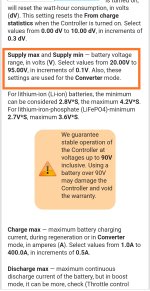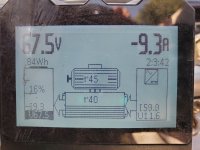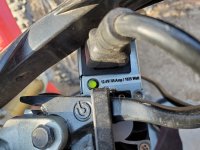You are using an out of date browser. It may not display this or other websites correctly.
You should upgrade or use an alternative browser.
You should upgrade or use an alternative browser.
Nucular Electronics owner's thread (setup infos, FW updates, links etc.)
- Thread starter madin88
- Start date
thoroughbred
100 W
I was in converter mode with a 12v power supply. I wanted to change the amperage setting so I toggled the enable parameter to "off" while the power supply was operating. I hear an immediate pop, smell of burnt electronics and the green LED on the power supply turns yellow. It now only puts out 3 volts so its obviously now damaged.
If this was a simple and obvious mistake on my part, is it described anywhere in the manual?
While I wait for a new power supply, is there any reason I can't try to charge my battery using an automotive 12v battery hooked up to a 15 amp 12v charger?
If this was a simple and obvious mistake on my part, is it described anywhere in the manual?
While I wait for a new power supply, is there any reason I can't try to charge my battery using an automotive 12v battery hooked up to a 15 amp 12v charger?
thoroughbred
100 W
https://www.rlpower.net/products/85-amp-power-supply
I've been using this for about 6 months and it has worked great. The only reason I was fiddling with the converter parameters is that I updated the firmware and the parameters in my saved configs wouldn't come across
I've been using this for about 6 months and it has worked great. The only reason I was fiddling with the converter parameters is that I updated the firmware and the parameters in my saved configs wouldn't come across
20 volts is the minimum voltage that the controller accepts. the closer the voltage of the power supply is to the battery voltage, the more efficient the converter, with 12v input you charge a battery of what voltage? It worked for a long time but today the power supply is fried so isn't good. It certainly overheated and when disconnecting it took the battery voltage in the teeth. If you charge an 80v battery with a 12v power supply, the majority of the 85A goes into heat loss. With a 60v 10A power supply you get the same final battery charge intensity.
How are you getting a 12V supply to work great when the spec'd minimum input is 20V?thoroughbred said:https://www.rlpower.net/products/85-amp-power-supply
I've been using this for about 6 months and it has worked great. The only reason I was fiddling with the converter parameters is that I updated the firmware and the parameters in my saved configs wouldn't come across
thoroughbred
100 W
11.6v and 59A input and 67.5v 9.7A output. :lol:
What's the point ?
The point of converter mode is to have plenty of power for fast charging.
If you charge your 20s battery with another 14s battery, for example, you will have better performance and a much higher charge intensity.
This is very handy when you want to do a quick partial charge. With a 12s 30A battery I charged my 20s battery at 25A for 20 min. This allowed me to gain a few Wh very quickly.
A 12v power supply is interesting when you have broken down on the side of road and a motorist stops to help you. You can save a few Ah by connecting to the battery of your car, but to charge the battery at 10A it is better to use a 20s 10A charger at 80€, rather than a 12v 85A power supply at 600€...
What's the point ?
The point of converter mode is to have plenty of power for fast charging.
If you charge your 20s battery with another 14s battery, for example, you will have better performance and a much higher charge intensity.
This is very handy when you want to do a quick partial charge. With a 12s 30A battery I charged my 20s battery at 25A for 20 min. This allowed me to gain a few Wh very quickly.
A 12v power supply is interesting when you have broken down on the side of road and a motorist stops to help you. You can save a few Ah by connecting to the battery of your car, but to charge the battery at 10A it is better to use a 20s 10A charger at 80€, rather than a 12v 85A power supply at 600€...
thoroughbred
100 W
PITMIX said:11.6v and 59A input and 67.5v 9.7A output. :lol:
What's the point ?
The point of converter mode is to have plenty of power for fast charging.
If you charge your 20s battery with another 14s battery, for example, you will have better performance and a much higher charge intensity.
This is very handy when you want to do a quick partial charge. With a 12s 30A battery I charged my 20s battery at 25A for 20 min. This allowed me to gain a few Wh very quickly.
A 12v power supply is interesting when you have broken down on the side of road and a motorist stops to help you. You can save a few Ah by connecting to the battery of your car, but to charge the battery at 10A it is better to use a 20s 10A charger at 80€, rather than a 12v 85A power supply at 600€...
My point was not to brag or suggest this as the best setup. The power source is one I had on hand to run another device and it happened to work ok the 20s surron. The parameters I set were ok for me as I thought they didn't push the power source to the max and 4 hours to charge was gentle on the battery. I think I was running the charging set up at around 600W. The oem surron is about 1000W. I didn't have to buy anything to go from 16S to 20S thanks to the converter function of the 24F.
I only posted the pics to show it actually worked fine for me for many cycles and then failed when I switched parameter to off while the rig was operating. Thanks for pointing out that in doing so I probably sent a voltage spike to the power source which killed something inside. I didn't know this was a possibility and have learned my lesson.
I don't see $100 20S chargers but I do see this https://www.ebay.com/itm/304352531152?hash=item46dcd312d0:g:N5MAAOSw-fRiBRoW
My question about an automotive 12v scenario was for getting by while waiting for a replacement. I have other DC sources in my shop like mig welders, car battery chargers , a couple of 48V Zero motorcycle chargers. I don't know enough about charging strategies since I'm only now realizing that maybe I should have been using the OEM surron charger as my power source in the first place :?
Shanevottero
1 µW
- Joined
- Apr 15, 2022
- Messages
- 1
Hi everyone I am experiencing an issue after installing my nucular 24f in my sur ron
When I went for a test ride it is stuck in reverse, and when I put it in reverse gear in goes forwards. It seems like a simple wire mix up but I am unsure which wires.
It seems like a simple wire mix up but I am unsure which wires.
If anyone had any suggestions on what to look for, or what wires I might have crossed?
The wires I am thinking are the problem is the motor to controllers connection
When I went for a test ride it is stuck in reverse, and when I put it in reverse gear in goes forwards.
If anyone had any suggestions on what to look for, or what wires I might have crossed?
The wires I am thinking are the problem is the motor to controllers connection
Need some help from the experts, got a new bike build with a new 24F same motor as my first build.
The set up went not good because off bad Hall sensors but this is now fixed. My problem is that the bike is runnig, but the power responce is strange. On a flat surface it doesent come straith on the throtlle. Its just like it has no torque, then just it comes on and wheelied. On flat it runs with 200 Amps, but when I hit a hill it just barelly runs in the 50 amps. My previous bike was the opposit. Did also throttle curves changes but it seems that nothing helps. Put in another battery but same issue. It just hasn't got the punch that my other bike did. Where do I have so search????
The set up went not good because off bad Hall sensors but this is now fixed. My problem is that the bike is runnig, but the power responce is strange. On a flat surface it doesent come straith on the throtlle. Its just like it has no torque, then just it comes on and wheelied. On flat it runs with 200 Amps, but when I hit a hill it just barelly runs in the 50 amps. My previous bike was the opposit. Did also throttle curves changes but it seems that nothing helps. Put in another battery but same issue. It just hasn't got the punch that my other bike did. Where do I have so search????
Solved the problem. The values in # Current change speed.
acceleration, select of values from 50A/s to 50000A/s, in increments of 100A/s.
braking, select of values from 50A/s to 50000A/s, in increments of 100A/s.
shutdown, select of values from 50A/s to 50000A/s, in increments of 100A/s.
After some playing with these values, the motor runs perfectly.
Love the 24F
acceleration, select of values from 50A/s to 50000A/s, in increments of 100A/s.
braking, select of values from 50A/s to 50000A/s, in increments of 100A/s.
shutdown, select of values from 50A/s to 50000A/s, in increments of 100A/s.
After some playing with these values, the motor runs perfectly.
Love the 24F
Darren2018
100 W
- Joined
- Aug 18, 2018
- Messages
- 223
This is probably a silly question but how do you connect the uLight to an isolated DC-DC? I thought you just disconnected the 12V from the controller and added the isolated DC-DC to those pins but when I spoke to Vasiliy he said something about leaving the +12V from the controller connected. I think he was trying to help me with the display staying on but I am not sure if I understood him correctly  . Can I even use the GND without the +12V from the DC-DC if it's isolated?
. Can I even use the GND without the +12V from the DC-DC if it's isolated?
frostnova37
1 mW
There are many examples of people using these controllers in bicycles and smaller framed motorcycles (Surron esk). How do they fair in full sized motorcycles? I'm doing a conversion of a DRZ 400 SM and the 24f + computer + ulight is a very attractive package, especially because I want the bike to be road legal. The only thing I'm hesitant about is the 20kw cap, looking at using a QS138 90h 4000W and people run these in the 25-30kw range.
j bjork
100 kW
I dont think it is enough. Too small and not enough thermal mass.
@Frostnova37
It is necessary to have a very high gear ratio to not force the engine and allow it to reach its maximum speed which is around 6000rpm in Field weakening.
If you want to keep the original transmission you will need a more powerful controller to avoid overheating and be able to drive beyond 120km/h.
https://youtu.be/nW1GPpRXtgI
It is necessary to have a very high gear ratio to not force the engine and allow it to reach its maximum speed which is around 6000rpm in Field weakening.
If you want to keep the original transmission you will need a more powerful controller to avoid overheating and be able to drive beyond 120km/h.
https://youtu.be/nW1GPpRXtgI
VasiliSk
1 kW
- Joined
- Apr 10, 2014
- Messages
- 418
You can cheat with split phase double controllerfrostnova37 said:The only thing I'm hesitant about is the 20kw cap, looking at using a QS138 90h 4000W and people run these in the 25-30kw range.
Username1
100 W
- Joined
- Nov 26, 2013
- Messages
- 168
I have a question about the upcoming BMS. It says "For cold weather, the BMS provides for heating the battery."
Can someone explain how this is done? It sounds almost too good to be true. So any standard cells would be able to heat themselves without any kind of heater installed?
Can someone explain how this is done? It sounds almost too good to be true. So any standard cells would be able to heat themselves without any kind of heater installed?





